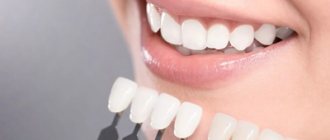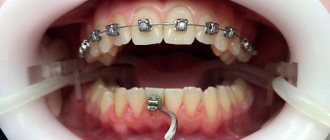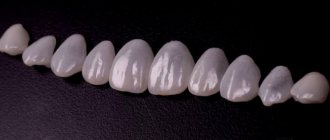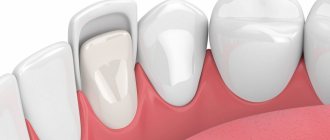From this article you will learn:
- what are veneers in dentistry,
- before and after photos, patient reviews,
- veneers – price for 1 tooth in Moscow (for 2022).
Veneers are microprostheses made of ceramic or composite filling material (in the form of thin plates) that cover the front surface of the teeth. The thickness of standard ceramic veneers starts from 0.6 mm, respectively, and the front surface of the tooth must be ground to the same depth (Fig. 1-3). However, in dentistry there are also so-called “thin veneers” - they are made from Emax glass ceramics. They have a thickness of 0.3-0.4 mm, which in some cases makes it possible to do without tooth preparation.
To complete the picture, it should be noted that there are also so-called ultra-thin veneers for the front teeth, which are produced by DenMat under the brand Lumineers® (Lumineers). The advertisement states that their thickness is only 0.2 mm, which is guaranteed to allow you to avoid grinding off the surface layer of tooth enamel. But this is not entirely true, and the original manufacturer's instructions already clearly indicate that the thickness of the lumineers will be from 0.3 to 0.7 mm (i.e. they will not be thinner than Emax).
What are dental veneers: photo
Correcting teeth with veneers allows you to improve their color and shape, allows you to change the inclination and position in the dentition, and also makes it possible to eliminate wide interdental spaces. Veneers are either “direct” (composite) or “indirect” (orthopedic). Composite veneers are made by dentists from ordinary composite filling material. They cost much less, and their aesthetics and service life are noticeably more modest - compared to higher quality indirect ceramic veneers.
In turn, orthopedic indirect veneers are made in a dental laboratory - mainly from various types of ceramics. The most common types of ceramics used to make veneers are porcelain, lithium disilicate, or zirconium dioxide. It is for such ceramic veneers that patient reviews will be as positive as possible, because... they really allow you to achieve excellent dental aesthetics (which can be seen in Hollywood stars). How much does it cost to install ceramic veneers? Read below.
Important: but patients are faced not only with the problem of choosing between ceramic and composite veneers (here it all comes down to budget). It becomes more difficult when the patient learns that ceramic veneers can be made not only from different types of ceramics, but there are also different technologies for their manufacture - the layer-by-layer ceramic application method, injection molding technique or CAD/CAM technology. And this also affects aesthetics and their service life.
Veneers for front teeth - indications for use
Veneers cannot be made on all teeth, but only on the 10 upper front teeth, as well as the 8 lower front teeth. These limitations are associated with too high a chewing load in the area of large chewing teeth. Veneers on the front teeth can correct:
- chipping of the cutting edge (Fig. 4),
- unattractive tooth color that cannot be improved by chemical whitening (Fig. 5),
- the shape of the teeth is not beautiful enough,
- spaces between teeth (Fig. 6),
- moderate crooked teeth that you want to correct without orthodontic intervention.
Ceramic veneers: before and after photos
How much does it cost to install veneers - price in Moscow
If you want to get what is called a Hollywood smile, you only need ceramic veneers, which will be made by an orthopedic dentist and dental technician of the highest qualifications, and from very high-quality ceramic mass. For such dental veneers, the cost in economy class clinics will start from 16,000 rubles, and in mid-price clinics - from 21,000 rubles (for 1 unit).
Of course, there is a much cheaper alternative in the form of composite veneers, which are made from a composite filling material directly in the patient’s mouth, in just 1 visit. The price for composite veneers for front teeth will be on average about 7000-9000 rubles (for 1 unit), and their minimum price in Moscow is from 4500 rubles. As for ceramic veneers, the price will depend on the type of ceramics used...
Ceramic veneers: cost for 2022
- from feldspathic ceramics (porcelain) – from 16,000 rubles.
- made of glass ceramics E.max PRESS – from RUB 21,000.
- from glass ceramics E.max CAD – from RUB 26,000.
- from zirconium dioxide - about 30,000 rubles.
Important: above we indicated how much dental veneers cost in Moscow - specifically in clinics in the mid-price segment. In different clinics there is a very wide range in prices for veneers, even made from the same materials. For example, the average price for 1 veneer from E.max PRESS should be about 21,000 rubles. However, in economy class clinics it can be only 16,000 rubles, and in others it can even reach 50,000 rubles.
When discussing the price with your doctor, it will be important to clarify whether they have a discount for the amount of work (if you do veneers on several teeth at once). When using veneers for 4-6 teeth, you can usually get a discount of up to 10-15%. We will immediately warn you that you should not look for clinics with the lowest prices. The latter will guarantee that your veneers will be done by an orthopedic dentist and a dental technician - not of the highest qualifications.
Feldspar ceramic veneers −
Dental feldspathic ceramics are also called porcelain. Porcelain was the first material from which veneers were generally made. It allows you to perfectly imitate the optical properties of real tooth enamel - its color and translucency. Porcelain veneers have very good aesthetics - no worse even in comparison with glass-ceramic veneers E.max (24stoma.ru).
Porcelain veneers: before and after photos
Porcelain veneers can be made using three different methods. Firstly, using the method of layer-by-layer application of porcelain mass, which implies that the ceramic mass is applied in layers and also baked in layers at high temperature. Secondly, by injection molding under conditions of high temperature and pressure (this method is preferable to the first, since the veneers will be much stronger).
Thirdly, there is feldspathic ceramics in the form of blocks, which are used for the manufacture of ceramic veneers/crowns using the milling method using a CEREC machine (CAD/CAM technology). An example of such material is “Vita Mark 2” Zahnfabrik, made in Germany.
Porcelain veneers – pros and cons, price
The main advantages are stunning aesthetics and affordable cost. The price for porcelain dental veneers in Moscow and St. Petersburg will be very affordable. For example, in economy class clinics it can start from only 12,000 rubles, and in mid-price clinics it will be about 16,000 rubles. But unfortunately, porcelain veneers also have some minor disadvantages...
For example, the flexural strength of porcelain layered veneers is only 50-75 MPa, which means there is a greater risk of porcelain chipping. When producing porcelain veneers by pressing or using CAD/CAM technology, the bending strength will be about 150 MPa. This is generally sufficient if you have a good bite and will not chew on anything hard. For comparison, veneers made from E.max have a bending strength of 370-400 MPa, but the price is 1.5-2 times higher.
Porcelain veneers before and after (video 1) –
In the video below you can see how amazing veneers on the front teeth made of feldspathic ceramics (porcelain) can look, which are indistinguishable from the most beautiful real teeth.
My disappointment with the order
My order didn’t take long to arrive and about 2 weeks later they called me from the post office and said that I had received a package. They sent it to me from the online store “INFINIT RETAIL” LLC (ESPP 026352).
I went and, without checking the parcel, brought it home. It was a large envelope with a small box. The box contained so-called veneers, or rather two pieces of plastic.
There were no instructions for these veneers, there was only a reminder from the buyer of the online store INFINIT RETAIL LLC. The advertisement said that the veneers were very easy to put on after placing them in hot water. But no matter how much I tried to put on these veneers, nothing worked. After unsuccessful attempts, I put them back in the box and hid them, because I didn’t tell the children anything and I was ashamed to admit that I was so stupidly deceived.
After a while, while doing another cleaning, I saw them and told the children about my story, we laughed and this box went into the trash.
But miraculously the envelope from this parcel was preserved, I don’t know how it happened that the envelope did not go after the box, probably so that I could tell you about my unsuccessful order of such wonderful Perfect smile veneers through the online store.
This package cost me 2177.82 rubles. The cost of veneers is 1780.00 rubles and postage costs are 397.82 rubles. This is certainly not a large amount, but the experience gained taught me not to make such orders on the Internet anymore.
Glass ceramic veneers E.max –
As we said above, ceramic materials for making veneers include not only porcelain and zirconium dioxide, but also glass ceramics E.max (). Today, this is the best option for making veneers, which combines the stunning aesthetics of porcelain veneers and high strength.
E.max is not just ceramics, it is glass ceramics. This material consists of translucent lithium disilicate crystals (i.e., it has a glass matrix, which in its optical properties is as similar as possible to real tooth enamel). In the hands of a qualified dental technician, E.max glass ceramics will give you the Hollywood smile of famous actors and music performers.
E.max veneers for front teeth: before and after photos
Emax veneers can be made from 2 varieties of this material - either from the “E.max PRESS” material or from the “E.max CAD” material. If you want to put veneers on your teeth, the price of E.max can vary greatly in different clinics, not only because of different pricing policies, but also because of the use of different E.max materials. How these materials differ – read below.
- Veneers from E.max PRESS (Fig. 10-11) – E.max PRESS glass ceramics are designed for the production of veneers/crowns using injection molding, which makes them very strong (flexural strength 400 MPa).
From this material you can make not only standard veneers with a thickness of 0.6 mm, but also so-called “thin veneers” - only 0.3-0.4 mm thick. Thin veneers require either minimal grinding of the enamel on the front surface of the tooth, or sometimes they can be installed without disturbing the enamel at all. Moreover, the small thickness does not affect their strength. A special feature of E.max PRESS is a wide range of color shades and a choice of the degree of transparency of the material, which allows the dental technician to make ideal veneers from this material.
- Veneers from E.max CAD (Fig. 12) – E.max CAD material is produced in the form of blocks intended for milling veneers/crowns on a CEREC program-controlled machine.
This technology is called CAD/CAM. By the way, exactly the same manufacturing method is used for zirconium dioxide veneers. The strength of veneers made from E.max CAD is about 360 MPa, which is also very good. Veneers made from E.max CAD are more expensive simply because their production requires very expensive equipment. As for aesthetics, E.max PRESS is a little better. This is due to the fact that E.max CAD has fewer options for selecting color shades and degrees of transparency of the material. As a result, there is a higher risk of mismatch between the veneers and the teeth adjacent to them - in color and transparency. And, by the way, thin veneers cannot be made from this material.
Important: we already wrote above how much veneers for the front teeth made of E.max glass ceramics cost. This is on average from 21,000 rubles for 1 veneer from E.max PRESS, and from 26,000 rubles from E.max CAD. Both materials are good, but you can safely choose the less expensive E.max pressed ceramic without worrying about its quality being inferior.
Trying on E.max veneers (video 2) –
Zirconium dioxide veneers –
Zirconium veneers are the most durable. If the veneers are made of opaque zirconium dioxide, their bending strength will be about 900 MPa, and if they are made of translucent zirconium dioxide, they will be about 550 MPa (which is also very high). This certainly eliminates the risk of porcelain chipping if the veneers are made from monolithic zirconium dioxide rather than by applying porcelain to a milled zirconium frame. But when it comes to aesthetics, zirconium veneers are inferior to both feldspathic ceramics and E.max glass ceramics.
Zirconium veneers: before and after photos
Problems with aesthetics are related to the characteristics of the material. The fact is that most dental clinics purchase so-called “raw” “soft” zirconium dioxide (it has a low price). And because Since this material is soft, it allows the clinic to save a lot of money - also on the need to change cutters for milling zirconium blocks less often. The problem is that this cheap zirconia is bright white and lacks translucency, so veneers made from this material will not be very aesthetically pleasing.
Important: however, there are also more expensive zirconia blocks - pre-colored / translucent (the latter thanks to the addition of yttrium), which allow you to make veneers of almost the same quality as veneers made from E.max PRESS pressed ceramic. Such materials include -
- the best option is the Katana® UTML material (Japan) - zirconium veneers from this material are practically not inferior to veneers from E.max PRESS,
- slightly more modest options are Katana® STML (Japan) or Prettau® Anterior (Germany) materials.
How much does it cost to install zirconium veneers?
The cost of veneers for front teeth made of good quality zirconium dioxide should be about 30,000 rubles (for 1 unit), plus or minus several thousand rubles. However, when using so-called “raw” zirconium dioxide, the minimum price we fixed in Moscow was 12,000 rubles, which is due to the low cost of such material.
Zirconium veneers on teeth (video 3) –
In the video above you can see that initially there are old, but still good fillings on the upper central incisors. Obviously, the doctor who posted this video is proud of the result, but let’s take a closer look at the manufactured veneers... It’s immediately clear that the so-called “body” of the veneers (in the middle third, as well as in the third closest to the gum) is too massive and absolutely opaque. And that is why these expensive zirconium veneers look more like cheap metal ceramics.
Secondly, the contrasting zone where the veneer transitions into the gum immediately catches your eye. And again, these look like cheap crowns. Therefore, we once again recommend that if you decide to make veneers from zirconium, then make them from a translucent material, for example, Katana® UTML (Japan). True, for this you will have to try hard, finding out exactly what they do in each clinic, and hope that you will not be deceived.
How to wear removable veneers
Considering that the reviews for removable veneers Perfect Smile are worse than ever, it’s not worth purchasing them. But, if you have already bought them and want to try them, the instructions contain the following steps: 1. Place the veneer on the tooth in boiling water for about two minutes. At the same time, the impression material that comes with the removable teeth is also lowered into the glass. When this plastic material becomes completely soft and changes color, you need to take it out. 2. The instructions for removable veneers warn that you need to wait 15-20 seconds before placing the plastic in your mouth to avoid burns. During this time, the plastic impression material is distributed over the inside of the artificial teeth using a spoon or whiskey, preparing for placement. 3. After waiting the required time, the jaw is inserted into the mouth. In this case, it is advisable to maintain the center line so that the smile does not appear skewed. Removable veneers on the lower teeth are put on according to the instructions, just like the upper ones. The main thing is to put them on so that the softened impression material is facing towards the natural teeth. 4. After the imprint of the teeth is obtained, the structure is taken out again into a glass, but with cold water , to record the result. When plastic hardens in water, it turns white. This can be seen on the inside of the record.
Further in the instructions it is proposed to blind everyone with a snow-white smile, although in practice this is, in principle, impossible. Especially if you put onlays on the lower jaw and upper teeth at the same time, you won’t be able to close your lips at all. All that remains is to remove the removable veneers and put them in a box, forgetting them forever.
CONCLUSION : Don't be fooled by advertising. There is no such thing as unisex removable veneers in dentistry. Any microprosthesis is made in the oral cavity individually for each patient, taking into account the anatomy of the teeth, jaws, age and gender. The same standard teeth cannot suit a young girl and an elderly man. Just like the same color of plastic teeth cannot look natural for people with different skin and hair colors. Therefore, it is better to read about how ceramic veneers are installed and not waste money on unnecessary toys.
How to install veneers on teeth -
If you have already decided on the type of ceramic veneers, this does not mean that you will get the beautiful teeth you dreamed of.
Prosthetics with veneers consists of the work of 2 specialists. Firstly, an orthopedic dentist who will grind your teeth, take impressions and then fix the finished veneers on your teeth. And secondly, a dental technician, who, based on the impressions taken in the dental laboratory, will actually sculpt your veneers from ceramic mass. Important: preparing teeth for veneers requires great skill, but it is even more difficult to find a great dental technician who will give the veneers a beautiful shape and will be able to take into account all the nuances of the color and translucency of the tooth enamel (otherwise the veneers will look like cheap metal-ceramics). There are only a few such dental technicians. In order not to be disappointed, you can ask to make a diagnostic mock-up/template for future veneers (called a mock-up).
The doctor makes such a template from a temporary composite material directly on the patient’s teeth (even before the stage of grinding off the enamel). The purpose of the template is to show you what the shape of your veneers will be and to agree on it with you. If you like the shape of your future teeth, agree to treatment. If you don’t like the dental aesthetics on the diagnostic mock-up template, you should look for another clinic. Believe me, this will save you from disappointment and loss of money.
Thick and thin veneers: installation
Standard dental veneers usually have a thickness: circularly along the front front surface of the tooth - about 0.6 mm, and along the cutting edge - from 0.7 mm (Fig. 17). Accordingly, the front surface of the teeth and the cutting edge will be ground to such a depth (Fig. 18), otherwise the teeth will look too massive. Normally, the thickness of the enamel layer on the front surface of the tooth varies from 0.3 to 0.5 mm.
It is very important (if possible) not to grind off the entire layer of enamel, otherwise the veneer will be fixed to the softer and darker layer of dentin. Firstly, this will worsen the aesthetics, and secondly, veneers are least susceptible to chipping when they are fixed to the hardest possible base, i.e. to enamel. Unfortunately, when using veneers with a standard thickness of 0.5-0.6 mm, this is not always possible, but here the so-called “thin veneers” help us out.
Thin veneers (Fig. 17) - this version of veneers has a circular thickness of about 0.3, and along the cutting edge - 0.4 mm. Thin veneers are made from pressed glass ceramics E.max PRESS. As a result, the thickness of the grinding of the tooth enamel is sharply reduced, the veneers are glued to a strong base (enamel), and thanks to the adhesive type of fixation, they become one with the tooth enamel, not inferior in strength to veneers of standard thickness. In some cases, thin veneers make it possible to avoid grinding the enamel altogether.
Some companies call their thin veneers the term ultraneers. The term lumineers is also known - this is the proprietary name of an American manufacturer of thin veneers, which are produced in the form of ready-made sets. Lumineers are installed without grinding the teeth.
Installation of veneers: video
The first video is grinding teeth for veneers; the second is the fixation of finished ceramic veneers.
Composite veneers
Installing veneers made of composites has certain disadvantages.
You can study reviews from patients who have already visited the dentist for this service. This will help you evaluate whether these veneers are right for you. We have collected information from specialists who work in the best dentistry in the country. They note that in the vast majority of cases, dentists create composite veneers directly during a session directly in the visitor’s mouth. This turns veneers into reinforced restoration fillings. The filling is distributed over the front surface of the tooth, but its cost is an order of magnitude higher than a traditional restoration. This technology has nothing in common with classic veneers and is unable to perform their functions. The production of high-quality composite veneers is carried out outside of dentistry - in the laboratory of a dental technician.
The task of dentists is to grind down the teeth to cover them with veneers and take reliable impressions of them. The impressions must be sent to the dentist. The specialist creates a veneer on a light composite, providing it with the necessary qualities. Such veneers acquire high performance properties, but their characteristics cannot be compared with porcelain and zirconium analogues.
Composite veneers: reviews from dentists
Tooth restoration with a composite veneer. Photos before and after
Considering modern composite veneers, one can note their modest aesthetic qualities. Such a coating is not capable of achieving the performance of ceramic veneers. Most patients encounter a problem when a visit to the dentist ends with the fixation of a veneer that does not match the rest of the teeth. Composite compositions are difficult to adapt to the characteristics of natural teeth.
Color stability of composite veneers
Among the indicators of composite veneers, the level of color stability ranks last. During use, such veneers gradually begin to lose their brightness and color. Varieties of ceramic veneers are not susceptible to this, since this material does not change color shade and translucency throughout the entire period of operation.
Strength of materials
Veneers made of composite material are more fragile than ceramic type veneers. Their reliability is incomparable to that of veneers made from zirconium compounds, which have unsurpassed strength. Due to their high fragility, such veneers are installed with the obligatory overlap of the cutting edge of the tooth. This means that you will no longer bite food with your own tooth, but with the veneer.
Manufacturing technology of composite veneers
Dental professionals face quite a difficult task. They need to create a high-quality veneer in your mouth. Achieving the goal is hampered not only by limited time, but also by high humidity and the presence of only artificial lighting. The desired color shade of the veneer can be achieved only by gradual layer-by-layer application of the filling composition. The required shade of veneer is selected for each layer. Creating high-quality veneers in laboratories takes longer and is much more expensive. As for their characteristics, these veneers will significantly surpass in their qualities analogues created in dentistry itself.
How to install veneers
The creation of veneers is carried out in several successive stages. First, the dental employee prepares the teeth. If outdated composite fillings are installed on the surface of the tooth or the patient used braces, they are removed. Old fillings are replaced with new ones if the procedure involves preserving the base of the filling after the preparation is completed. This not only improves the aesthetics of the veneer, but also improves adhesion between surfaces.
The second stage of work includes choosing the color shade of the veneers. For this purpose, special scales of shades and colors are used. They are standard and present in any dentistry in Moscow. In addition to tools, the specialist focuses on the client’s personal wishes.
Next, they begin to prepare the teeth. Installation of veneers is carried out after grinding down about 0.5 - 0.7 mm of the natural tooth enamel located on its front surface. At the same time, the installed fillings are polished. The exact size of the enamel layer to be polished is determined individually in dentistry.
The fourth step is making dental impressions. Impressions can be made after the teeth have been prepared. They are sent to a dental technology laboratory operating in dentistry. During the period of production of permanent veneers, the patient is given a temporary alternative. Temporary veneer is designed to protect the patient’s exposed teeth from aggressive environments and food contact with their surface. As part of the laboratory stage, accurate plaster models of the client’s teeth are made. They are necessary to create the most accurate veneers from ceramic or zirconium alloy.
This example shows the stages of placing veneers. Photos before and after
At the final stage, the veneers are fixed using special pastes of two different colors. The color of the cement is matched to the color of the dental client’s enamel, as this determines the final shade of the finished veneer. The dentist’s task is to give the veneer a tone that is as close as possible to the color of the adjacent teeth. The desired shade can be achieved by alternating two shades of fixing pastes. A permanent veneer is glued onto the prepared base.
While in dentistry, you can conduct a dialogue with a specialist and tell him about your claims regarding the quality of the veneer, its color or shape. From the moment the veneer is secured with permanent cement, nothing can be changed. It is easier to remove braces than to adjust permanent veneers.
Ceramic veneers: patient reviews
Patient reviews of ceramic veneers in most cases are enthusiastic, because they really can make you the owner of a Hollywood smile. But, this is only if your veneers are done by a truly highly qualified dental technician. In addition, it is very important that the clinic you go to has its own dental laboratory.
This will allow the prosthodontist and dental technician to make decisions together while standing at the chair, and the dental technician will then have the opportunity to look at you in the chair, allowing him to select the best color and translucency option for your veneers.
Advantages of ceramic veneers –
- Highest aesthetics.
- Complete color stability - they do not darken or fade over time, as happens with composite veneers.
- High reliability - service life is limited only by extreme circumstances, such as injury, and ranges from 12 to 25 years in most cases.
The only drawback of such veneers is their cost. But a natural question arises: how can veneers made from a thin layer of porcelain 0.3-0.5 mm thick be strong at all? There are not many clinical studies in the world on the strength of veneers and their service life. However, we tried to find them (you can see the results below).
- The results of the study (author - Smales, 2004) - the “survival rate” of veneers 7 years after their manufacture was: after 7 years, 86% of veneers made without overlapping the incisal edge functioned perfectly, and their owners had no complaints about them .
However, for veneers made with incisal overlap, the survival rate was 96%. This suggests that, firstly, ceramic veneers with an overlapping incisal edge are more reliable, and secondly, that after 7 years only 4% of patients had any problems and complaints about the manufactured veneers. In addition, if suddenly the veneer falls out over time, you can bring it to the dentist, and they will immediately reattach it to you.
- The results of a similar study (Leighton, 2007) - based on an assessment of 304 porcelain veneers installed in one hundred patients showed: after 5-6 years, 96% of veneers were intact, after 10-11 years - 93%, after 12-13 years - 91% and 73% of veneers were intact even after 15-16 years.
As we see from these studies, in some patients the veneers periodically failed. The main reasons that led to the unsuitability of veneers were chips of ceramics, cracks, and loss of veneers. As we see: all this happened, but in a small percentage of cases. In addition, if the veneer falls out, it can easily be reinstalled on the tooth. But a crack or chip in the ceramic will require replacement of the veneer.
In addition, veneers often became unusable due to the patients themselves. Firstly, poor hygiene led to the appearance of caries near the veneer and subsequent tooth destruction. Secondly, injury to teeth/veneers as a result of impact, gnawing on nuts and seeds. Thirdly, sharp temperature changes (hot coffee + ice cream) led to cracks in veneers.
Important: taking into account the results of these studies, one must keep in mind that over the past 10-15 years since the research, new types of ceramic materials and manufacturing technologies have appeared, which have made it possible to further increase the strength and service life of ceramic veneers.
What are Lumineers?
Lumineers are called next-generation dental veneers or “Hollywood veneers.” What is the peculiarity of such veneer structures, and why have they earned a universal vocation worldwide and are a revolutionary means for the restoration of damaged human teeth included in the smile line?
Lumineers, by their nature, are ceramic veneers, but much thinner. The thickness of such a veneer is 0.2-0.3 millimeters. In appearance, it is almost transparent and looks fragile, but this is not so: lumineers are resistant to mechanical damage.
Historically, the rights to develop and create lumineers belong to the company Cerinate (USA), but today the production of such veneers is carried out in dental laboratories around the world. The LeaderStom dental clinic also offers its patients the opportunity to manufacture and install veneers of this type. Lumineers are positioned as a revolutionary product that allows solving the problems of aesthetics of human teeth without grinding the supporting elements. This is what sets them apart from other dental veneers and makes them unique.
Since the practice of installing lumineers in our country goes back several decades, during this time a lot of patient reviews about these structures have accumulated. Let's try to figure out what the result of fixing new generation veneers on teeth actually looks like and what should we expect from installing thin ceramic dental onlays?
Veneers made from composite filling material –
Those who have made veneers from composites know that they have significant disadvantages.
You will find detailed information about the level of patient satisfaction with such veneers in the “reviews/service life” section. As we have already said, composite veneers in Russia in 95% of cases are made by dental therapists directly in the patient’s mouth, but there is also a technology for their manufacture in a dental laboratory. In fact, such a veneer is a regular filling that occupies the entire front part of the tooth. Composite veneers on the 6 upper front teeth –
The aesthetics of composite veneers are very far from the aesthetics of ceramic veneers. If you take a closer look at the before and after photos (posted just above), you will see that veneers made from composite do not have the translucency that natural tooth enamel has, and they also have a slightly unnatural milky color. However, such veneers also have undeniable advantages.
Firstly, the cost of composite veneers is at least 2-4 times lower than ceramic ones. Secondly, they can be done in just 1 visit. True, they have much more disadvantages and, of course, if you are very demanding in terms of aesthetics and reliability, then veneers made from a composite filling material are unlikely to suit you (read about the disadvantages of such veneers at the link above).
Reviews of composite veneers –
Composite veneers - service life is approximately 2-3 years or 3-4 (if you're lucky). We must remember that such “veneers” need periodic polishing, but in any case, over time they will darken and fade, and after 4-5 years they will look like this -
Study (by Wakiaga, 2004) - assessed patient satisfaction with composite veneers. It was conducted based on a survey of 200 people over a 2.5-year after they received composite veneers. The satisfaction rate was only 67%, in contrast to, for example, satisfaction with ceramic veneers (93%).
However, for the latest study it is necessary to make allowances for Russian reality. As we have already said: the quality of manufacturing composite veneers abroad is much higher, so you should not create any illusions that cheaper composite veneers will look like expensive ceramic ones.
Where is the best place to place veneers?
It's no secret that aesthetic operations such as the installation of veneers should be carried out only in serious and trusted clinics. From the best specialists. They are professionals in their field, with thousands of successfully performed veneering and aesthetic dental restoration operations behind them.
Why do we offer installation of veneers here, in our clinics?
All-Russian
The rating of private dental clinics in 2022 confirmed
the leadership
of the German Implantology clinics and the “Clinic over 3 years old”.
11,000 of the best
Russian dental clinics from more than 110 cities fought for the right to be the first, and we again became the best in Russia!
The award ceremony took place on September 23, 2022
within the framework of the largest dental exhibition in Russia -
DENTAL EXPO 2019
and
on September 22, 2022
at the
DENTAL EXPO 2020
.
In the category “Clinics up to 3 years of age” - the clinic of the Research Center in Ramenki:
In the category “Clinics over 3 years old” - the clinic of the Scientific Research Center on Kievskaya,
which has been successfully performing dental implantation for more than 9 years:
Veneers: contraindications
When you can’t put veneers on your teeth - reviews from dentists indicate that breakage of veneers (which will require their replacement, with associated costs) is most likely in the presence of the following conditions:
- increased tooth wear of grade 2 and higher,
- absence of chewing teeth (sixth, seventh),
- extreme lifestyle (boxing and other contact sports),
- presence of bruxism,
- bad habits - biting threads or nails, opening beer with teeth,
- You cannot install veneers on teeth treated with resorcinol-formalin,
- severe destruction of the lingual (inner) surface of the tooth,
- the presence of a medium or large filling on the lingual surface of the tooth,
- incorrect bite (direct or reverse).
Veneers: pros and cons
Below we will give answers to questions that patients often ask when consulting an orthopedic dentist regarding the installation of veneers...
What is better - veneer or crown?
First of all, veneers can be done on any teeth, but with the exception of 6-7-8 chewing teeth. Secondly, they can only be done in the absence of contraindications, which we listed above in this article. If there is at least one contraindication from this list, it is advisable for you to opt for crowns. What to choose - veneers or crowns (in the absence of contraindications), then the best choice is definitely veneers.
For a veneer, the tooth is ground down mainly only from the front surface, which allows you to preserve not only more of the tooth’s own tissues, but also leave the tooth alive. This will certainly increase its service life. Thin veneers require grinding down the enamel by only 0.3 mm, and the tooth for the crown is ground down on all sides by an average of 1.5-2 mm (which makes it look like a stump).
A tooth ground for a metal-ceramic crown –
What is better – veneers or restoration?
Porcelain veneers have a unique property - they are able to completely imitate your own tooth tissue. This happens because both tooth enamel and porcelain are equally translucent and reflect light equally. In healthy teeth, light rays pass through the tooth enamel and are reflected from the denser and darker dentin underlying the enamel.
After reflection, the light rushes back, which gives the enamel a shiny, somewhat glassy appearance. The same thing happens with porcelain veneers: light passing through them is reflected from the darker cement and rushes back. In addition, with the help of special pigments, you can give porcelain any shades that will imitate the color and transparency of neighboring healthy teeth.
But the light-polymer/composite filling material, which is used for restorations, does not have the same characteristics of light transmission and translucency. Therefore, the aesthetics of filled front teeth are very far from ideal, unless, of course, you are really picky about aesthetics. Take a closer look at the restored teeth - they are always grayer and duller than healthy teeth (Fig. 26).
Restorations are not only inferior in aesthetics initially, but they also have the property of darkening over time, and therefore after a few years they usually require replacement. In addition, very often a dark line appears at the tooth/filling border over time (due to the penetration of pigments), which already worsens the aesthetics. But porcelain veneers will not change their color at all even after 20 years.
A few words about what veneers are
Veneers are overlays that are installed on the front surface of a person’s teeth along the smile line. Using special compounds, the veneer overlays are fixed. But before carrying out this procedure, the dentist must prepare the patient’s teeth: carry out professional cleaning with removal of tartar, and then sharpen them.
Grinding teeth involves removing a layer of hard tissue up to 1.5 mm thick. After preparation, a thin layer of enamel should remain on a person’s teeth, to which veneers are subsequently attached. This is the main reason why veneers cannot be placed on people with thin enamel: fixation of the structure to dentin will not be strong and reliable.
At the next stage, impressions are taken of a person’s teeth and sent to a dental laboratory, where the veneers themselves are made from them. During the production of permanent veneers, temporary plastic veneers are fixed to the patient’s teeth.
The veneering procedure takes place in several stages and the patient visits the dentist three to five times. In addition, it is possible to create and install composite veneers in one visit or fix lumineers to teeth without preliminary grinding. What this procedure is and what are the reviews about it will be discussed later in the article.










